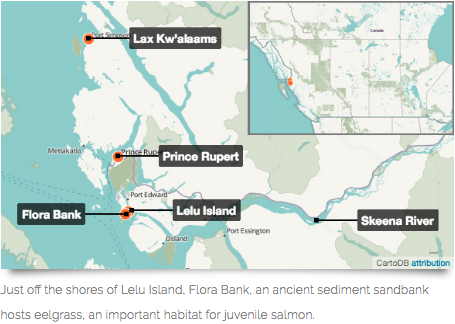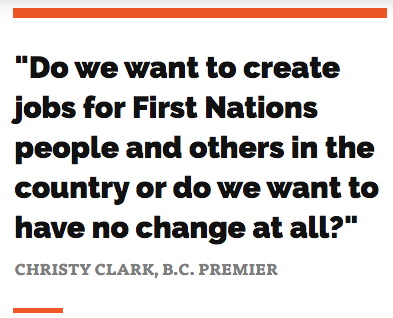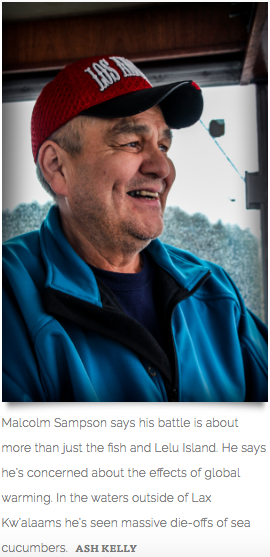
Shad: ‘Nature isn’t just a pastime, it’s a practical and spiritual need’
As he celebrates 20 years making music, the beloved rapper shares what he’s learned about...
By Ash Kelly and Brielle Morgan for Discourse Media. For a full, interactive version of this investigative piece, visit Discourse Media.
For more than 5,000 years, First Nations people have collected plants and harvested red cedar on Lelu Island, which sits where the Skeena River meets the Pacific Ocean near Prince Rupert in northern British Columbia. Adjacent to some of the most critical salmon habitat on the West Coast, Lelu Island is considered so valuable that, according to local Indigenous oral histories, Indigenous tribes have long battled to control it.
Not much has changed today — except that the battleground has shifted to Victoria and Ottawa. Prime Minister Justin Trudeau’s government is set to make a decision about Pacific NorthWest LNG (PNW LNG)’s proposed $36-billion liquefied natural gas (LNG) project, which is majority-owned by the Malaysian energy company Petronas. That decision could come at any time, although deliberations are likely to stretch into the fall. If built, the project will link a pipeline that weaves through traditional First Nations territories with a conversion plant and shipping terminal on Lelu Island.

Last year, members of the Lax Kw’alaams First Nation, whose traditional territory includes Lelu Island, overwhelmingly rejected the proposed development on the island — and almost $1.2 billion in promised benefits. Clark claims a breakthrough with Lax Kw’alaams occurred earlier this spring. “The Lax Kw’alaams voted massively in favour of supporting LNG, with some conditions,” she stated at the June 3 press conference.
But locals in the tiny town of Lax Kw’alaams, many too afraid to put their view on the record, say no such vote occurred. The only vote on the proposed project that Discourse Media was able to substantiate is the vote that occurred at a series of meetings in May 2015, when a majority of community members voted against the benefit agreement proposed by PNW LNG.
The political pressure on Lax Kw’alaams since then has been immense. Locals describe a community deeply divided over its future, desperate not to miss out on the economic opportunity LNG could provide, but with a majority opposed to developing Lelu Island. “Everybody’s bickering and fighting. It is tearing the whole village apart,” says Corinne Dudoward, who has lived in Lax Kw’alaams all her life save for a few years off reserve to attend school.
With sparring between elected and traditional power brokers, death threats and alleged vandalism, a culture of fear has left community members feeling they haven’t been heard by provincial or federal politicians. Pledges by both governments to meaningfully consult with the Lax Kw’alaams people have been broken, according to many community members.
Flora Bank, an eelgrass habitat in the Skeena River estuary, is adjacent to Lelu Island. Research found that Flora Bank contains higher abundances of juvenile salmon than other locations in the estuary. Photo: Tavish Campbell
While Trudeau has a relationship to foster with Clark, he has also promised a renewed “nation-to-nation” relationship with Indigenous peoples based on “recognition of rights, respect, co-operation and partnership,” as stated in his mandate letters to ministers in November. He reiterated this when Minister of Indigenous and Northern Affairs Carolyn Bennett committed to the U.N. Declaration of the Rights of Indigenous Peoples (UNDRIP) in May.
Central to UNDRIP is Indigenous peoples’ right to “free, prior and informed consent” when it comes to proposals like PNW LNG. “Especially in cases of large-scale development or investment projects that may have a major, severe or adverse impact on Indigenous Peoples’ territories, consent is necessary,” wrote Indigenous legal scholar Dalee Sambo Dorough in Northern Public Affairs. “The state must provide all relevant information well in advance of the decision making.”
“It means developing and maintaining a more balanced and respectful relationship,” says Senator Murray Sinclair, former chair of the Truth and Reconciliation Commission. “It’s more than simply saying, ‘We’re going to stop taking your land away from you unless it’s really important.’” He says projects like PNW LNG are an opportunity for Trudeau to demonstrate his commitment to reconciliation.
In May, just two days after Bennett drew a standing ovation at the U.N. for committing to UNDRIP, a group of First Nations people from the Skeena region also stood before the U.N.’s Permanent Forum on Indigenous Issues. 
The one thing everyone seems to agree on? That, had the consultation process been handled differently, free, prior and informed consent could have been achieved, PNW LNG could have been a success story for the Lax Kw’alaams, Petronas, Clark and Trudeau — and Lelu Island could have been protected for the use of future generations of Lax Kw’alaams people. Instead, it descended into one of the most polarized and contentious resource development battles that Canada has witnessed in years.
“Energy projects can proceed in a way that does achieve the purposes of reconciliation,” says Sinclair, “but not the way that we’re currently doing them.”
The Battle for Lelu Island Lands in Ottawa
PNW LNG has become one of the most contentious resource development battles that Canada has witnessed in years, and the battlefront has shifted to Ottawa.
Earlier this year, Premier Clark, four cabinet ministers and a delegation of over 80 people including industry representatives and First Nations travelled to Ottawa for what was dubbed a “trade mission.” PNW LNG has registered seven new lobbyists since the Liberals’ November election. First Nations groups opposing the development have also made multiple trips to Ottawa and the U.N., supported in part by conservation groups.
In addition to their conflicting demands, Trudeau’s government must weigh climate commitments made at the Paris Climate Conference at the end of 2015. The Canadian Environmental Assessment Agency has concluded that PNW LNG is “likely to cause significant adverse environmental effects … as a result of greenhouse gas emissions.” In fact, in late May, nearly 100 scientists said in a group letter to Minister of Environment and Climate Change Catherine McKenna that PNW LNG “would add between 18.5 per cent and 22.5 per cent to [B.C.’s] total GHG emissions,” making it “virtually impossible for B.C. to meet its GHG emission reduction targets.”
Divide and Conquer: The Threatened Community at the Heart of the PNW #LNG Project https://t.co/yLdU5i06F9 @CFNGBI pic.twitter.com/TyITpjqwv7
— DeSmog Canada (@DeSmogCanada) July 7, 2016
It’s unclear whether First Nations were consulted before key decisions were made concerning PNW LNG. Shaun Stevenson, Prince Rupert Port Authority (PRPA)’s vice president of trade development, says the PRPA acknowledges that the port exists on traditional territory and expects developers to engage with First Nations as “early as possible.” A 2014 report by PNW LNG suggests initial contact with Lax Kw’alaams occurred in December 2012. But at least six months prior, Petronas had already earmarked Lelu Island for its plant and signed a feasibility agreement with the PRPA.
Community members in Lax Kw’alaams were open to development that would bring economic opportunity to the region, but they were concerned about how developing Lelu Island would impact salmon. Three years after being initially contacted, plans to locate the LNG plant on Lelu Island seemed set in stone, even though band members had received little response to their concerns about environmental impacts. And so, in spring 2015, some of them occupied the island in protest.
Ken Lawson and his wife, Patty Dudoward, are on the frontline of this occupation. A trucker and a fisherman by trade, Lawson never imagined he and Dudoward would spend the better part of a year shuffling between their home in Prince Rupert and the camp on Lelu Island, organizing food and fuel and assisting other activists at the occupation. As a house leader in the Gitwilgyoots tribe, one of the Nine Allied Tribes of Lax Kw’alaams, Lawson is often called upon by his hereditary chief to speak for the community.

In April 2015, PNW LNG presented Lax Kw’alaams with a benefits proposal totalling nearly $1.2 billion in payments and land transfers that would be delivered over 40 years. The mayor of Lax Kw’alaams at the time was Garry Reece. Wanting to better understand the impacts on salmon and dissatisfied by information provided by PNW LNG, Reece’s band council commissioned consultant and geologist Patrick McLaren and Simon Fraser University biologist Jonathan Moore. Their research found that Lelu Island’s proximity to Flora Bank, a sandbar where juvenile salmon spend time transitioning between the river and the ocean, meant that development on the island posed significant threats to the salmon run.
The CEAA’s draft report to the federal government ran counter to McLaren’s and Moore’s findings, arguing that “taking into consideration mitigation measures … the Project is not likely to cause significant adverse environmental effects on marine fish and fish habitat.” Experts have called into question the CEAA’s findings. On March 11, a group of 134 scientists submitted a letter calling on Minister of Environment and Climate Change Catherine McKenna to reject the CEAA’s draft report; they said the government report is “scientifically flawed and represents an insufficient base for decision-making.”
In May 2015, Lax Kw’alaams-commissioned scientists and PNW LNG representatives presented their contrasting views at a series of public meetings called by Mayor Reece to consider PNW LNG’s benefits proposal. The meetings occurred in Lax Kw’alaams, Prince Rupert and Vancouver (the vast majority of band members live outside of Lax Kw’alaams).
In all three locations, large majorities of attendees rejected the deal. Two days after the final vote in Vancouver, the band council released a statement: the band would not support LNG on Lelu Island, but was open to collaborating to find an alternative plan. “Lax Kw’alaams is open to business, to development, and to LNG (including PNW). It is not open to development proximate to Flora Bank,” the statement reads.
Those occupying Lelu Island felt bolstered by the vote, confident that they represented the view of their community. “What it’s all about for Christy Clark is the jobs, and I get that. There aren’t a whole lot of jobs around,” says Ken Lawson from his vantage point on Lelu Island. “They just simply can’t put it on Flora Bank, Lelu Island. Put it somewhere else.”
“If they had asked where to put this in the first place, [the community’s] answer would probably be different,” says Lawson. “There would have been proper consultation — which there wasn’t.”
PNW LNG didn’t take up Lax Kw’alaams on its offer to find another location. But that didn’t mean the deal was off.
Grant Wesley, son of Malcolm Sampson, says he and his family are leaving Lax Kw’alaams because they don’t know who they can trust anymore. They’ll decide where to go once his girlfriend knows where she’ll be attending school to become a teacher. Wesley’s father says he’s been targeted for his anti-LNG views. Photo: Ash Kelly
Premier Clark’s confidence in the venture was not lessened by Lax Kw’alaams’ rejection, according to reports by APTN and CBC. She reportedly said it was “only a matter of time” until a deal was reached with Lax Kw’alaams and the rejection was nothing more than “a bump in the road.”
At the Western Premiers’ Conference in May 2016, Discourse Media asked Clark what responsibility her government has to Lax Kw’alaams. She responded: “Do we want to create jobs for First Nations people and others in the country or do we want to have no change at all?”

Four of the five First Nations that the CEAA and the B.C. Environmental Assessment Office required PNW LNG to consult with — Metlakatla, Kitselas, Kitsumkalum and Gitxaala — have signed either impact benefit agreements (securing payouts for their communities along with environmental commitments from PNW LNG) or term sheets, which are often a precursor to impact benefit agreements.
With Lax Kw’alaams emerging as the sole holdout among those five First Nations (some upriver tribes that harvest Skeena salmon, including the Wet’suwet’en and Gitanyow, are also opposed), Lawson and Dudoward found themselves under increasing pressure from locals who felt they and their fellow occupiers were standing in the way of jobs and prosperity. “It feels like Ken’s and [my] heads are on the chopping block,” Dudoward says. They also acknowledge a lack of visible public support for their position, which they find understandable, but frustrating. “People are afraid of what could happen to them if they helped us out,” said Lawson. “They have to protect themselves and their jobs. I don’t hold that against anybody.”
Lawson himself is paying a toll for standing up. “I’ve logged all my life and I’ve run trucks for the last 12 years,” says Lawson. “The business has suffered… big time.”
In a smoke-filled teepee on Lelu Island, where the occupiers often debrief, Lawson talks about the recent breakdown of one of the trucks in his commercial fleet. Under the hood, he found a hole in a component behind the engine, one he believes was an act of sabotage. After inspecting the damaged part, his insurance company agreed it didn’t appear to be a wear hole. An investigation is underway.
Malcolm Sampson, a Lax Kw’alaams fisherman for more than 40 years and an outspoken activist against PNW LNG, also became a target for those in the community who disagreed with him. He recalls one phone call that made this particularly clear.
“You see that big hotel sitting there?” he asks, pointing to a modest, weathered building he owns. “I was threatened they were gonna burn it down. A man threatened to come up to my house and he was gonna shoot me and all my children,” he says. “My heart fell to my knees; I almost cried.”
Police in Prince Rupert say they have seen an increase in calls resulting from the controversial nature of these large-scale LNG projects. Sgt. Jagdev Uppal of the Prince Rupert RCMP adds: “This has included marine-based offences such as dangerous operation of motor vessels and uttering threats (complaints).”
James Anaya, U.N. Special Rapporteur on the rights of Indigenous peoples, could have been describing the situation playing out in Lax Kw’alaams when he criticized Canada’s relationship with Indigenous people in a 2014 report. When consultation does not take place in a consistent and timely manner, he wrote, the result is “an atmosphere of contentiousness and mistrust that is conducive neither to beneficial economic development nor social peace.”
Murray Smith, a house leader from the Gitwilgyoots Tribe, believes PNW LNG proponents are stoking divisions in his community by taking advantage of internal governance challenges. “They look for the weak link, people that are hungry for money,” he says. “They see that they’re poor and say, ‘Sign your name here.’”
Despite this mounting pressure, elected and hereditary leaders remained relatively united in their opposition to LNG development on Lelu Island — until a new mayor and council were elected in November 2015.
At first, the newly elected leaders maintained the community’s position. Mayor John Helin even submitted a letter to the CEAA reiterating the band’s rejection of the benefit deal on March 7, 2016.
But eight days later, in a move that hereditary leaders call a betrayal, Helin submitted a second letter to the CEAA that contradicted his earlier letter and offered conditional support for a project. The letter was dated March 15, when several elected councillors were away on an annual kelp-gathering trip on Digby Island.
Community members in Lax Kw’alaams were shocked. According to Smith, “the last time we had a band meeting was in a previous administration,” before Helin’s November election. Many Lax Kw’alaams community members corroborated this.
The band council is not required under lawto make financial or governance documentation available to the public. But, according to former mayor Reece, a band member can request meeting minutes at the band council office. So on April 8, after a prolonged silence from the elected council, fisherman Malcolm Sampson went to the band office and requested any relevant minutes from meetings concerning the letter.
Instead of providing the requested documentation, according to Sampson, the band council shut down the office and an impromptu protest ensued that resulted in someone calling the RCMP. By the time police arrived, there was little action. Const. Monte Webb describes the protest as “three cops and thirty people standing around just talking.”
Mayor Helin declined to comment in response to multiple interview requests made by phone, email and text message. When approached by Discourse Media reporters in person, he held his hand up and said “no.”
Discourse Media also reached out to each band councillor with publicly listed contact information. Only councillor Stan Dennis responded. Dennis says he is not at liberty to provide details on how the council operates, but stated for the record: “I am still standing against this development on Lelu.”
Helin’s contentious letter became a speaking point for Premier Clark. At the Western Premiers’ Conference in early May, she said Lax Kw’alaams leadership “voted overwhelmingly in favour of moving forward into the next stage of this agreement on LNG.”
In multiple interview requests, Discourse Media asked Clark to elaborate. In an emailed response, the premier’s office stated, “First Nation officials carried out their own internal engagement processes prior to their vote and letter of support to the federal government.”
Then, in a follow-up phone call, a spokesperson for the premier who spoke on background explained that Clark may have misspoken when she referred to a “leadership” vote and that it was in fact a public meeting where the community voted 244 to three in favour of developing Lelu Island.

But have they? Neither the premier’s office nor the band council provided any documentation of either a band council or community vote in response to multiple requests. Discourse Media has been unable to identify a single community member who attended or was aware of a public meeting that was supposedly attended by between 150 and 247 people.
PNW LNG declined multiple interview requests and provided a written statement: “PNW LNG is working collaboratively and constructively with local First Nations. To date, PNW LNG has received conditional support from all local First Nations within the project area. We do not comment on band governance issues.”
Malcolm Sampson hasn’t shied away from pressing council to explain what happened in those eight days between letters to the CEAA; he is circulating a petition demanding answers and organizes occasional protests outside the band office. But he’s not sure how long he can keep it up; he no longer feels safe in the community.
“I’m going to try and sell what I can here and then maybe move on. We don’t feel liked here,” says Sampson. “It’s sad. It hurts to leave because I’ve lived here all my life.”
Image: Ash Kelly
Get the inside scoop on The Narwhal’s environment and climate reporting by signing up for our free newsletter. Angello Johnson’s shoulders burn, and his arms...
Continue reading
As he celebrates 20 years making music, the beloved rapper shares what he’s learned about...

B.C. allows industrial logging in critical habitat for at-risk species — part of the reason...

Lake sturgeon have long been culturally significant and nutritionally important to First Nations in Ontario,...
